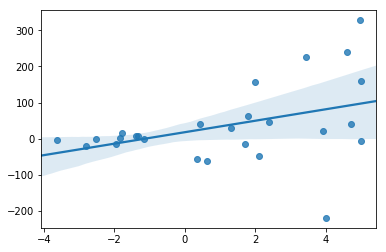异方差问题
Ordinary Least Squares (OLS) 需要四个 - -有些人说五或六个 - 假设要满足,但建模时我们经常会遇到异方差(Heteroskedasticity)问题,
那是因为,很多数据都表现出这种“异方差性”。我们通常可以直观地解释原因:
- 随着年龄的增长,净值往往会出现分歧
- 随着公司规模的扩大,收入趋于分化
- 或者,随着婴儿身高的增加,体重趋于分散
OLS的主要假设之一是数据的残差相同的,当不满足同方差的假设时,即存在异方差时候,我们需要另外的方法--加权最小二乘法(WLS)去处理。

WLS实例
import numpy as np import pandas as pd import seaborn as sns import statsmodels.api as sm # generate random data np.random.seed(24) x = np.random.uniform(-5,5,25) e= 2*np.random.randn(25) y = 2*x+e
# alternate error as a function of x e2 = e*(x+5) y2 = 2*x+e2 sns.regplot(x,y); sns.regplot(x,y2);

可以看到,这些集合来自相同的实例函数,但是作为x的函数的增加的方差导致橙色模型拟合不同于蓝色的线。 在另一个随机抽取中,斜率可能低于蓝色,但一般会更加不稳定。
# add a strong outlier for high x x_high = np.append(x,5) y_high = np.append(y2,160) # add a strong outlier for low x x_low = np.append(x,-4) y_low = np.append(y2,160) sns.regplot(x_high,y_high);

sns.regplot(x_low,y_low);

上面的第一个附加模仿了一个常见的情况,即高方差区域(预期)会看到极端观察。 这将比WLS更多地影响OLS,因为WLS将减去方差及其“惩罚”。
计算样本权重,我们添加的错误随(x + 5)的变化而变化; 我们可以使用它来对值进行反向加权。
# calculate weights for sets with low and high outlier sample_weights_low = [1/(x+5) for x in x_low] sample_weights_high = [1/(x+5) for x in x_high]
# reshape for compatibility X_low = x_low.reshape(-1, 1) X_high = x_high.reshape(-1, 1) # import and fit an OLS model, check coefficients from sklearn.linear_model import LinearRegression model = LinearRegression() model.fit(X_low, y_low) # fit WLS using sample_weights WLS = LinearRegression() WLS.fit(X_low, y_low, sample_weight=sample_weights_low) print(model.intercept_, model.coef_) print('WLS') print(WLS.intercept_, WLS.coef_)
需要注意的是,WLS中的斜率受到低异常值的影响。 低区域应该具有低可变性,因此异常值被放大到高于OLS的范围,推动斜率更负。 让我们看下面如何在WLS中抑制高异常值。
model = LinearRegression() model.fit(X_high, ymod) WLS.fit(X_high, ymod, sample_weight=sample_weights_high) print(model.intercept_, model.coef_) print('WLS') print(WLS.intercept_, WLS.coef_)
总结
这是WLS的一个基本介绍,在这个领域还有很多东西要探索。例如:在建模时始终寻求使用经验或先验信息。使用模型的残差 - 例如,如果var(εi)=σ2x_i* var(εi)=σ2x_i 那么我们可以决定使用w_i = 1 / x_i。
如果响应是n观察的平均值,则类似var(y_i)= var(ε_i)=σ2/ n_i * var(y_i)= var(ε_i)=σ2/ n_i,那么我们可以决定使用w_i = n_i。
有时我们知道异方差的类型。在这种情况下,我们可能决定使用权重与测量误差的方差成反比。